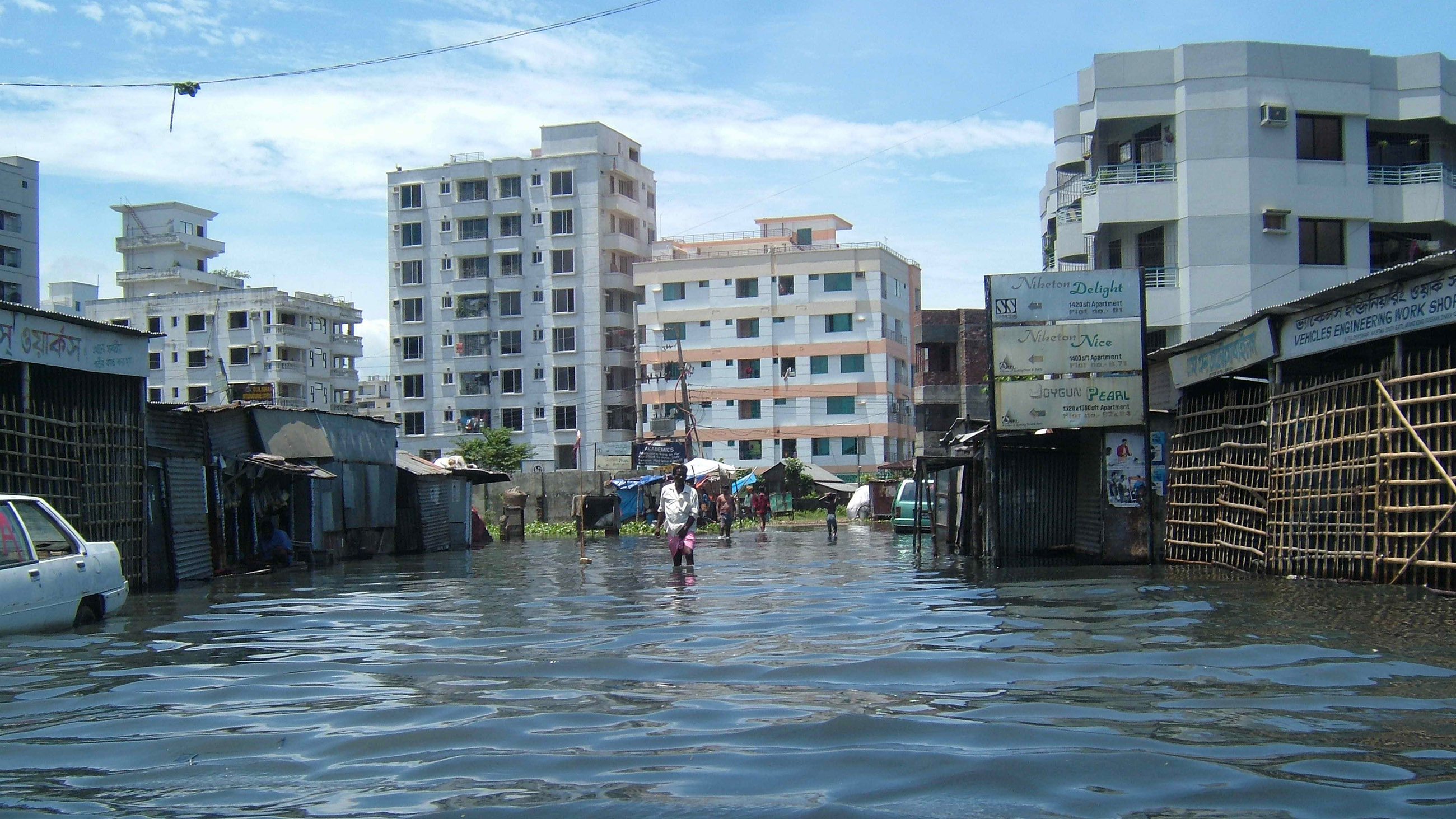Will Developing Nations Hack the Climate?
One of the inherent injustices of climate change is that its greatest impacts tend to fall on nations that had little role in creating the problem, and few resources available to deal with it. Bangladesh, for example, produced less than half a metric ton of carbon dioxide emissions per capita in 2011, according to data from the World Bank. The global average was 4.9 metric tons. The United States generated 17 metric tons.
And yet, as a low-lying nation with a large population, Bangladesh routinely faces a barrage of tropical storms, flooding, and drought that it doesn’t have the economic resources to deal with. According to the United Nations, between 1980 and 2008, Bangladesh experienced 219 natural disasters, which resulted in $16 billion of damage. More recently, the financial analytics and global credit rating firm Standard & Poors identified Bangladesh — along with other impoverished or developing nations like Cambodia, Vietnam, Mozambique and Senegal — as being among the nations most vulnerable to extreme weather and other climatic shifts.
“[Nations] will probably be unevenly affected by climate change,” the S&P report noted, “with poorer and lower-rated sovereigns typically hit hardest, which could contribute to rising global rating inequality.”

Could geoengineering be part of the solution for developing nations like Bangladesh to avoid the worst effects of climate change?
(Visual by Amanda Jennings, AusAID)
Following the Paris climate conference last December, 177 countries have signed an agreement to keep global average temperatures from rising more than two degrees Celsius above pre-industrial levels. The agreement is meant as a starting point, with countries providing updated plans every five years. But if the plans laid out aren’t enough, vulnerable nations may have little choice but to consider more drastic measures.
In some cases, that might mean mass relocations. In a more worrying scenario, it might mean taking global climate matters into their own hands.
“If you were the Prime Minister of Bangladesh and tens of millions of people were going to die from a famine — and you saw credible evidence that solar engineering would help you grow food again — it would seem to me hard for a politician to resist the political pressure to do something, even if it was only marginally effective,” said Ken Caldeira of the Carnegie Institution for Science. “I think in a crisis situation, it could be compelling.”
The concept of hacking the climate has been around since the 19th century, and efforts have been carried out on various scales. But it’s really in the last decade that the idea of geoengineering has come into serious consideration as a possible strategy in the fight against climate change. From mimicking the cooling effects of volcanoes to dumping iron into the oceans to increase the density of carbon-absorbing phytoplankton, geoengineering could take a variety of forms — and some of them might be well within the reach of a nation, or group of nations, made desperate by rising seas, ravaging storms, and lack of global cooperation on the issue.
Caldeira says an international consensus on large-scale geoengineering projects would seem unlikely, but that might not stop severely distressed nations from acting alone.
According to David Keith, a professor in physics and public policy at Harvard University, it would only take 25,000 tons of sulfuric acid, injected into the stratosphere by jumbo jets, to slash the current level of global warming in half after just one year. The sulfur would react with water vapor and disperse across the globe, reflecting a small but immediately effective percentage of the sun’s energy back into space. Of course, that regimen would have to be maintained and increased over time, to compensate for ongoing carbon pollution, so that by 2040, stratospheric seeding with sulfuric acid would require about 250,000 metric tons of the stuff and nearly a dozen or so jumbo jets. The cost at that point: about $700 million annually, Keith told the MIT Technology Review in 2013.
That might seem expensive, but it’s just a tiny fraction of Bangladesh’s current GDP of $195 billion. In that sense, a little freelance geoengineering might seem like an attractive option for a country seeking to protect its citizens — particularly when current estimates suggest that rising seas could displace as many as 18 million Bangladeshi residents by 2050.
But even if that country could perform an atmospheric sulfate dump without international consent, or without support from more powerful countries, Andy Parker, a research fellow at the Institute for Advanced Sustainability Studies in Potsdam, Germany, suggests it would likely be more of a gesture than an actual attempt to cool the planet. “The goal of the spraying might be to draw attention to the fact that they are suffering from a problem they did not cause,” Parker said, “and to highlight that the world needs to think seriously about how it deals with the warming we’re causing.”
As it currently stands, much of the international discussion of geoengineering takes place among rich, developed countries, rather than those nations that stand to benefit the most — should such extreme tactics prove viable. At the Climate Engineering Conference in Berlin in 2014, Parker said a large effort was made to include people from developing countries, but that a lot more work needs to be done. He directs a project called the Solar Radiation Management Governance Initiative, which has held meetings about solar engineering in countries like Pakistan, Senegal, and Ethiopia.
Of course, large-scale geoengineering remains mostly a matter of conjecture, and its proper role — if one even exists — in addressing global climate change remains a matter of stark disagreement among the world’s experts. Some small-scale experiments have been carried out, but to date, no nation has a plan in place to implement a large-scale project. A 2015 National Academy of Sciences report recommended that research continues to determine the viability of geoengineering technologies, but it also noted that it should not be considered a substitute for reducing greenhouse gas emissions.
Indeed, focusing on carbon dioxide reductions is one way to ensure that vulnerable nations won’t be forced to seek untested, 11th-hour solutions on their own, suggested Pablo Suarez, Associate Director for Research and Innovation at the Red Cross/Red Crescent Climate Center.
“Desperate solutions,” Suarez said, “can only emerge from insufficient action at earlier stages.”
Kristan Uhlenbrock is a freelance writer and a program specialist at the U.S. Climate Variability and Predictability Program in Washington, D.C.











Comments are automatically closed one year after article publication. Archived comments are below.
There is this interesting game-theoretic model of the energy transition (with international negotiation represented as the stepwise search for a 100 year Nash equilibirium): http://dl.acm.org/citation.cfm?id=2480114. It would be cool to add in the geo-engineering option and see how it alters the dynamics.
These cost estimates are probably way too high. They reflect only the most obvious, not the most optimal, ways of delivering sunlight-reflecting aerosols to the stratosphere in a highly controlled way. Nathan Myhrvold, Lowell Wood, Ken Caldeira, Jordin Kare, and other inventors at Intellectual Ventures came up with a far less expensive approach nine years ago called the Stratoshield: http://www.intellectualventureslab.com/invent/introducing-the-stratoshield
Simulations by Wood and Caldeira found that a system such as this could effectively halt and reverse the dwindling of the Arctic ice cap at a capital cost probably closer to $100 million, with annual operations costs in the millions. http://www.intellectualventureslab.com/assets_lab/Stratoshield-white-paper-300dpi.pdf
This study didn’t advocate for the use of such systems, but did point out that a) it would be smart for society to develop technologically, economically, and politically acceptable contingencies plans to combat runaway warming, and b) it would be irresponsible to deploy such systems if scientists hadn’t already thoroughly studied the potential side effects and ecological ramifications, so that research should be going on now. Since 2009, much of the atmospheric and climate science community has come around to this point of view as well. What hasn’t sunk in fully is that the costs of developing and deploying geoengineering systems are small enough that they could easily be undertaken either by countries (like Bangladesh) that see global warming as an existential threat or countries (like Saudi Arabia or Russia) that see curtailment of fossil fuel use as a dire threat to their economic and political stability.
CIA director John Brennan addressed geoengineering on June 29, 2016
https://www.cia.gov/news-information/speeches-testimony/2016-speeches-testimony/director-brennan-speaks-at-the-council-on-foreign-relations.html
“Another example is the array of technologies—often referred to collectively as geoengineering—that potentially could help reverse the warming effects of global climate change. One that has gained my personal attention is stratospheric aerosol injection, or SAI, a method of seeding the stratosphere with particles that can help reflect the sun’s heat, in much the same way that volcanic eruptions do.
An SAI program could limit global temperature increases, reducing some risks associated with higher temperatures and providing the world economy additional time to transition from fossil fuels. The process is also relatively inexpensive—the National Research Council estimates that a fully deployed SAI program would cost about $10 billion yearly.
As promising as it may be, moving forward on SAI would raise a number of challenges for our government and for the international community. On the technical side, greenhouse gas emission reductions would still have to accompany SAI to address other climate change effects, such as ocean acidification, because SAI alone would not remove greenhouse gases from the atmosphere.
On the geopolitical side, the technology’s potential to alter weather patterns and benefit certain regions at the expense of others could trigger sharp opposition by some nations. Others might seize on SAI’s benefits and back away from their commitment to carbon dioxide reductions. And, as with other breakthrough technologies, global norms and standards are lacking to guide the deployment and implementation of SAI.”
Kristan writes: “…research continues to determine the viability of geoengineering technologies.”
A natural approach…
The Man Who Planted Trees: Lost Groves, Champion Trees, and an Urgent Plan to Save the Planet
Sustainable Land Development Initiative – http://www.triplepundit.com/2012/07/man-planted-trees-lost-groves-champion-trees-urgent-plan-save-planet/
“It’s amazing for one layman to come up with the idea of saving champion trees as a meaningful way to address the issues of biodiversity and climate change. This could be a grass roots solution to a global problem. A few million people selecting and planting the right trees for the right places could really make a difference.”
Dr. Rama Nemani, Earth Scientist